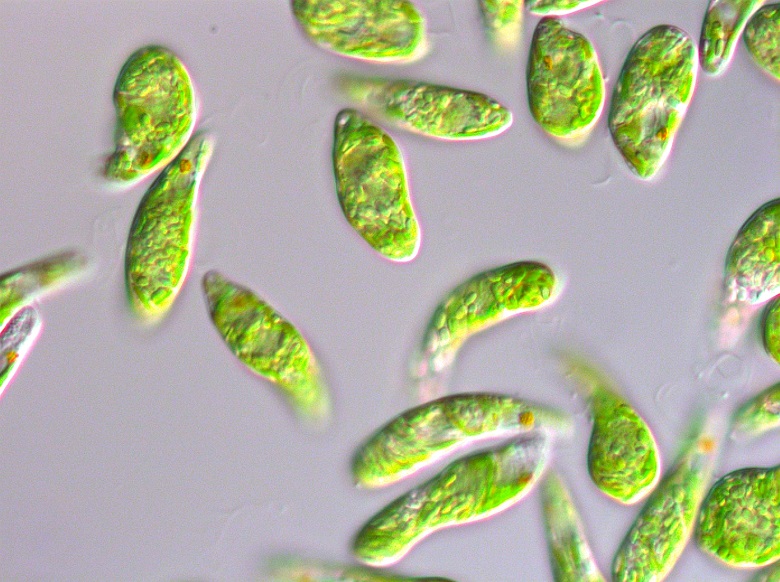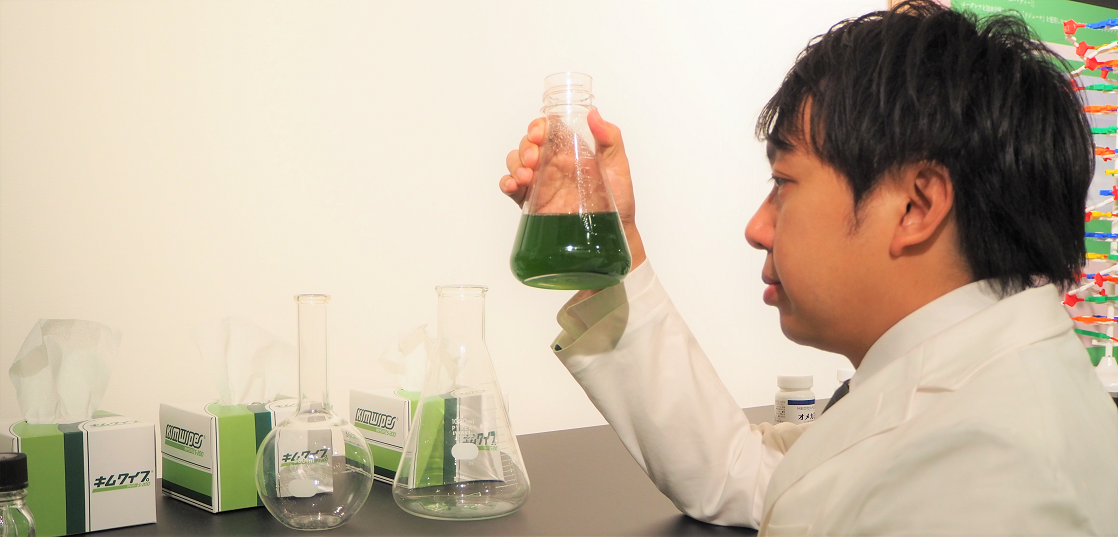世界で初めてミドリムシの食用屋外大量培養にユーグレナ社が成功してから約15年。
その成功を支えた研究者であり創業メンバーの一人である鈴木が、研究や事業活動から考えるサイエンスやビジネスについて記載します。
今回のテーマはずばり「ミドリムシに魅せられるわけ」です。
ミドリムシとの出会い
私がミドリムシの研究に携わるようになったのは、大学3年生の時です。研究対象として面白く、また産業活用できるなど社会貢献できる可能性のある生き物を探している中で、たどり着きました。純粋に研究対象として面白いと思った生き物は他にもありましたが、産業活用の難易度やインパクトを考えた時にミドリムシを超えるものはありませんでした。
ミドリムシの研究を始め、ミドリムシのことを知れば知るほど、その可能性に興味が惹かれていきました。大学の指導教授には他のテーマの研究案も提示されていたのですが、ミドリムシの研究を進めていきたいと思い、卒業論文もミドリムシに関することにさせていただきました。その後、修士課程、博士課程と研究を進め、現在に至りますが、今もミドリムシの可能性に魅せられ続けています。
今回は、そんなミドリムシの無限の可能性についてご紹介したいと思います。
ミドリムシの産業活用までの道
まずはじめに、人類がいかにミドリムシの可能性に注目してきたかということをご紹介したいと思います。
ミドリムシを最初に発見したのは、アントニ・ファン・レーウェンフックというオランダの科学者といわれています。彼は、顕微鏡の発明者であり、多くの微生物の発見者でもありました。彼は1600年代にミドリムシを発見し、スケッチブックに描きとめていました。これが最古の記録と考えられます。後にこの生き物がまるで美しい目を持つような見た目から「Euglena(Eu美しい + glena目)」(学名)と名づけられたといわれています。

赤く美しい目を持つように見えることが「Euglena」と名付けられた理由といわれている
その後、20世紀に入りミドリムシの研究は加速度的に進みます。1950年ごろにはアメリカの科学者メルヴィン・カルヴィンがミドリムシを用いて光合成の仕組みを解明し、後にノーベル賞を受賞しました。また、1970年代からはミドリムシを利用した効率の良いタンパク質生産の可能性が検討され、ミドリムシの培養や栄養価についての研究が進みました。1990年代からは国産旅客機の設計者でもある近藤次郎博士(東京大学名誉教授)がミドリムシを用いた食料生産と二酸化炭素の固定化の同時実施を提唱するなど産業活用の検討が進みました。
実際に産業で活用するためには、ミドリムシの屋外大量培養が欠かせませんが、まさにこれがボトルネック(課題)になっていました。私たちユーグレナ社は、多くの研究者の知見や経験に助けられながら、この課題に取り組み、2005年12月に世界で初めて、ミドリムシの屋外大量培養を成功させることができました。その後、当社はミドリムシを食品や化粧品、バイオ燃料などの産業に活用し、現在に至ります。
ミドリムシの産業活用における可能性
ミドリムシの特徴を一言でいうと、ハイブリッドということです。ちなみにハイブリッドという言葉の本来の意味は、豚とイノシシの掛け合わせであるイノブタのラテン語が語源になっていて、「交雑した種」という意味です。本来の意味とは少し違うのですが、ミドリムシは植物と動物の両方の性質を持ち合わせるハイブリッド的な生き物と言っていいかもしれません。ミドリムシは光合成で蓄えたエネルギーを成長に使いながら、光が多いなどの生活環境が整ったところに動く生存戦略をとることができるからです。
これはミドリムシが植物のように光合成で育ちながら、栄養価の高い動物性タンパク質を作れることを意味していています。このようなハイブリッド的なミドリムシの特徴は、産業活用において非常に魅力的です。なぜなら、光合成により二酸化炭素を固定化することで環境問題に貢献でき、また良質なタンパク質は世界の栄養問題の解決に貢献できる可能性があるからです。

ミドリムシの進化に関する研究の魅力
ミドリムシの特徴はハイブリットだと述べましたが、ミドリムシは、イノブタのようなハイブリッド種が生まれるようにオスとメスの掛け合わせで誕生したのではなくて、葉緑体を持たない原生動物が緑藻類を取り込んで葉緑体を持つようになったと考えられています。
このことは、ミドリムシの遺伝子解析などが進んだこともあり、いろいろな裏付けがとられてきていますが、まだまだ分かっていないことも多い現状です。というのも、ミドリムシは一般的な植物プランクトンなどと比較して何十倍のゲノムサイズであり、その複雑さにより全容が明らかにされていません(蛇足ですが、アメーバはヒトゲノムの100倍以上の大きさがあるともいわれていて、この生き物の解析はさらに難解です)。
このミドリムシの誕生や進化の道筋の解明、またそれを裏付けるミドリムシの遺伝子情報の解析自体も、ミドリムシの生物としての特殊性から大きな研究テーマになっています。現在も植物遺伝子の専門家の先生と理化学研究所でこの大きなテーマの解明に取り組んでいて、ミドリムシを研究対象とする魅力の1つになっています。
ミドリムシの無限の可能性
他にもミドリムシにはまだまだ研究すべきことがたくさん残っています。例えば、ミドリムシは酸素がない状態に置かれると自分の細胞の中に油を蓄える仕組みがあります。この油はジェット燃料などの原料に活用することができ、次世代のバイオ燃料の原料として非常に有力です。先に述べたミドリムシの遺伝子の情報が詳細に分かれば、どのような種類のミドリムシがどのような形で目的の物質をつくるのかがわかるので、これらの情報を研究することはとても重要です。
また、ミドシムシが持つ物質の中に、我々の健康増進に寄与するものもたくさん見つかっており、植物によくみられるカロテノイドをはじめとして、特定の有用物質を効率よく作ってもらうことで産業化できる可能性も大きいと考えています。今後はこの分野でも研究を促進していくつもりです。
このように、ミドリムシは単細胞生物なのですが、その小さな体に実にいろんな可能性が詰まっています。私は、ミドリムシを研究しているとき、まるで小宇宙のようだと思う時があります。なぜミドリムシに魅せられるのかと聞かれると、ミドリムシには無限の可能性があるからとお答えすることができるでしょう。

株式会社ユーグレナ 執行役員研究開発担当
鈴木 健吾(すずき けんご)
東京大学農学部生物システム工学専修卒、2005年8月株式会社ユーグレナ創業、取締役研究開発部長就任。同年12月に、世界でも初となる微細藻類ミドリムシ(学名:ユーグレナ)の食用屋外大量培養に成功。2016年東京大学大学院 農学博士学位取得。微細藻類ミドリムシの利活用およびその他藻類に関する研究に携わるかたわら、ミドリムシ由来のバイオ燃料製造開発に向けた研究に挑む。
東京都ベンチャー技術大賞受賞(2010年)、共著に『微細藻類の大量生産・事業化に向けた培養技術』(株式会社情報機構)。

